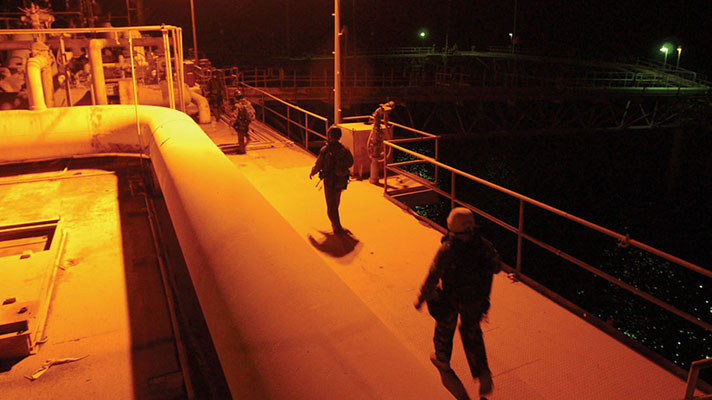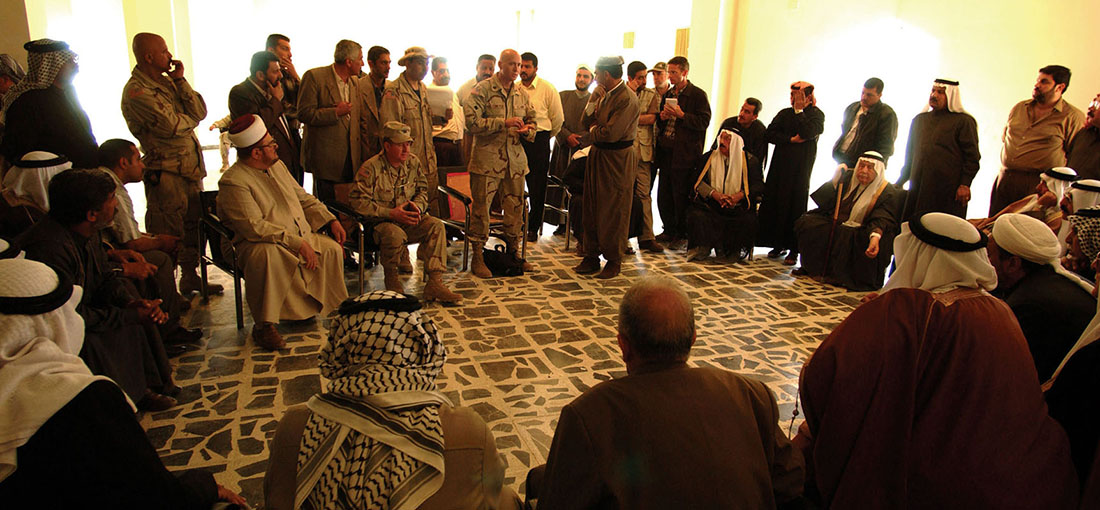DOWNLOAD
Some of the most exciting news reported during Operation Iraqi Freedom (OIF) has been the result of the Department of Defense’s (DoD’s) program to embed media with frontline troops, including special operations forces (SOF). Embedding has allowed reporters and camera crews to not only record operations and events, but to some extent experience the action themselves. Such intimacy has given the media and the public new insight into the lives and the trials of SOF personnel. The close cooperation has also provided leaders and troops with the opportunity to learn how best to work with the media and turn the attention to their advantage.
In January and February 2003, the DoD issued Public Affairs Guidance (PAG) for activities in the U.S. Central Command (CENTCOM) Area of Responsibility (AOR), which became the basis for all other PAGs in OIF. In contrast to the fairly restrictive policies initially followed in Operation Enduring Freedom (OEF), the DoD guidance for OIF seemed to go out of its way to accommodate media interest: “The Department of Defense (DoD) policy on media coverage of future military operations is that media will have long-term, minimally restrictive access to U.S. air, ground and naval forces through embedding.”1
The same PAG spelled out the rationale behind the DoD’s new openness and seemingly newfound realization that publicity was an effective tool of national security: “Media coverage of any future operation will, to a large extent, shape public perception of the national security environment now and in the years ahead. This holds true for the U.S. public; the public in allied countries whose opinion can affect the durability of our coalition; and publics in countries where we conduct operations, whose perceptions of us can affect the cost and duration of our involvement.” The PAG also revealed an attitude that bordered on “if you can’t beat them, join them”: “We need to tell the factual story—good or bad—before others seed the media with disinformation and distortions, as they most certainly will continue to do.”2
While special operations forces were included in the DoD policy, the special circumstances of their missions did allow for variations in application of the embedding plan. As public affairs officer (PAO) Lieutenant Commander (LCDR) Kevin Aandahl prepared the PAG for Special Operations Command Central (SOCCENT), he was able to negotiate with the office of the Assistant Secretary of Defense for Public Affairs, Victoria Clarke, to ensure that reasonable compromises between SOF concerns and the embedding directive could be reached. The most important concession was that media embedded with SOF would not be indefinitely placed with troops, but would be assigned on a mission-by-mission basis. This policy would still provide for media access during pivotal operations, but would also allow SOF commanders to maintain crucial control over operations and security.3
In keeping with SOF’s special status, and the high-profile nature of SOF participation in recent operations, SOCCENT was able to request and get specific reporters from the media pool, even though the DoD embedding plan assigned slots to media organizations and not to individuals. SOF embeds were chosen with such factors in mind as seniority, past work with SOF, physical fitness, and readiness to travel. Among those reporters chosen to embed with SOCCENT were Kelly O’Donnell from MSNBC, Jonathan Ewing from Associated Press, James Dao from the New York Times, and Jim Sciutto and Drew Millhon from ABC News.4 At the height of the war, the SOCCENT PAO was responsible for coordinating eighteen embedded reporters or news teams.5
Even as the process for selecting media embeds proceeded relatively smoothly, LCDR Aandahl ran into problems filling out the PAO requirements for the various SOCCENT component commands. By mid-December, only two of the four component commands—the Joint Special Operations Air Component and the Naval Special Warfare Task Group—had PAOs assigned to them. Joint Special Operations Task Forces (JSOTFs) North and West both lacked PAOs, and every time an appropriate officer was identified, the request for assignment was denied. After Major (MAJ) Tim Nye spent months processing a number of such personnel actions at the U.S. Special Operations Command (SOCOM) PAO, JSOTF-West finally received a PAO and Nye himself became the JSOTF-North PAO.6
MAJ Nye joined the 10th Special Forces Group (SFG) in Stuttgart, Germany in early February 2003. From the intermediate staging base (ISB) in Stuttgart, the 10th SFG was to move to a staging base in Turkey, but those plans were changed when Turkey objected to the U.S. using their bases in preparation for the invasion into Iraq. Romania was chosen as the alternative launch point, and the 10th SFG and attached personnel arrived in Constanta on 3 March 2003. While the selected media teams “embedded” with the 10th SFG in Constanta, MAJ Nye and MAJ Rob Gallen opened a Joint Information Bureau (JIB) in downtown Constanta in order to keep the non-embedded media away from the actual staging base, which needed to keep a low profile. As part of the effort to deflect attention away from the Special Forces presence, the staging base was passed off as a transit base for equipment and personnel. To sate media curiosity and redirect interest, the JIB even conducted a press conference at the “transit” base, complete with guided tour. The tour turned out to be one of the largest press events in Romania in over a decade.7
Back in Qatar, LCDR Aandahl continued to coordinate the various component PAOs and associated embedded media in preparation for the war. Since SOF embeds generally did not remain with a unit for an extended period of time, they found themselves waiting in Qatar for mission assignments. Aandahl and his staff went to great lengths to maintain operational security, and generally the media cooperated with the procedures. Many continued to question the PAO, trying to ferret out details of their prospective assignments, but they also entered the spirit of the “game” created by security requirements. Reporters and media crews enjoyed receiving mission instructions that seemed to be taken from a spy novel. Such directions as “You will be met by a man in the lobby of your hotel … ,” and “Fly to Bucharest … ” were met with amusement and occasionally astonishment: “That’s in Romania!”

The first opportunity for Aandahl’s team to prove how well media embeds could work for SOF came on 21 March 2003, when representatives from Fox News and The New York Times arrived on location just hours after special operations personnel liberated several gas and oil platforms (GOPLATS) off the Iraqi coast. The reporters and camera teams captured the military and environmental significance of the operation, and were prepared to release the story immediately. While the approval process had been streamlined since OEF and all footage and copy had been cleared for release, this particular story was delayed by General Tommy R. Franks, CENTCOM commander, who wanted to wait until all platforms had been secured before releasing details. The delay came to the attention of General Richard B. Myers, Chairman of the Joint Chiefs of Staff, and in the Defense Department briefing on 21 March, he settled the issue by announcing in reference to the platform operations that “there were embedded media with the SEALs, and their reports should be out shortly.” With that statement, SOCCENT PAO received permission from CENTCOM to release the stories, along with combat camera images recorded during the operation.8
With the infiltration of 10th SFG into northern Iraq, the JSOTF-North PAO found himself on the frontlines of military–media relations. MAJ Nye escorted an ABC News television crew as they accompanied 10th SFG on a joint offensive with Kurdish Peshmergas (Patriotic Union of Kurdistan—PUK) against Ansar al-Islam forces in and around the city of Halabjah. The news crew primarily remained on the hilltops surrounding the valley of Halabjah, interviewing soldiers at their observation posts in the SF teams’ few quiet moments between receiving hostile fire and calling in air strikes on the enemy below. As the soldiers saw that the media was obeying the PAG and were not going to break security by filming them from the front or revealing their full names, soldiers accepted the news crew and even began to volunteer their own stories.9
At the conclusion of the battle, a PUK commander scheduled a press conference in Halabjah. In order to maintain control of the situation, Nye organized the event and 3rd Battalion, 10th SFG commander Lieutenant Colonel (LTC) Kenneth Tovo presided. While it was unusual for SF ground commanders to participate in press events, the Halabjah conference provided LTC Tovo with the opportunity to officially state what had and had not happened during the battle. With PAO coaching, Tovo carefully explained that Task Force Viking was only in the area to support PUK forces, and that while troops had secured a suspected chemical weapons facility, the scientists were still evaluating the site and no conclusion had been made regarding the presence of weapons of mass destruction. In cooperating with the press instead of stonewalling them, SF mitigated the possibly negative effects of the inevitable publicity given the operation.
An unexpected side effect of the success of the embed program was that unembedded media sometimes became unofficially embedded with SOF units. One reporter embedded himself with the Kurds, which made him de facto embedded with the SF troops fighting in Halabjah. MAJ Nye directed the soldiers to continue to follow the PAG for media interaction, and in the end the reporter produced such SF-favorable articles that the troops treated him as an official embed and allowed him the same access as the PAO-assigned news crews. Safety issues also created relationships where there had been none, as happened in Mosul. Soon after the Halabjah operation, MAJ Nye joined 2nd Battalion, 10th SFG in rendezvousing with their commander, LTC Robert Waltemeyer at the airfield on the edge of Mosul. As Nye entered the terminal building to meet with the commander, he was shocked to see large numbers of reporters colocated with the troops. Waltemeyer had offered the media shelter from the bombardment, effectively embedding them all with his battalion in the process.

LTC Waltemeyer’s actions that day, and for the rest of the week, gave further evidence of the more congenial relationship that had developed between SOF and the media. MAJ Nye arrived in Mosul to find that LTC Waltemeyer and COL Charlie Cleveland, 10th SFG commander, had already scheduled a press conference for that day (and Nye was expected to run it). In an effort to stop violence between the Kurds and the Arabs, the SF commanders used the high profile conference to announce that 2nd Battalion was in control of Mosul and all warring factions would ultimately answer to them. Waltemeyer continued to hold daily press conferences and personal interviews, indicating that he was not only at peace with the media, but welcomed it as a vital aspect of governance.
Less than a month after the war began, SOF had proven that they were not only willing to cooperate with the media, but welcomed the presence of embedded news teams on selected missions. The Department of Defense’s directive that the military would accept media embeds was carried out both by military leaders and at the individual troop level, making the embed program a success within the SOF community. From MAJ Nye’s perspective as a PAO responsible for making the embed program work, the SOF soldiers carried out the embed program “in a very professional manner. They understood the importance of it, they understood the mission, and they never tried to impede it.” The result has been better media coverage and greater public understanding of SOF’s role in military operations, a situation that benefits all involved.
